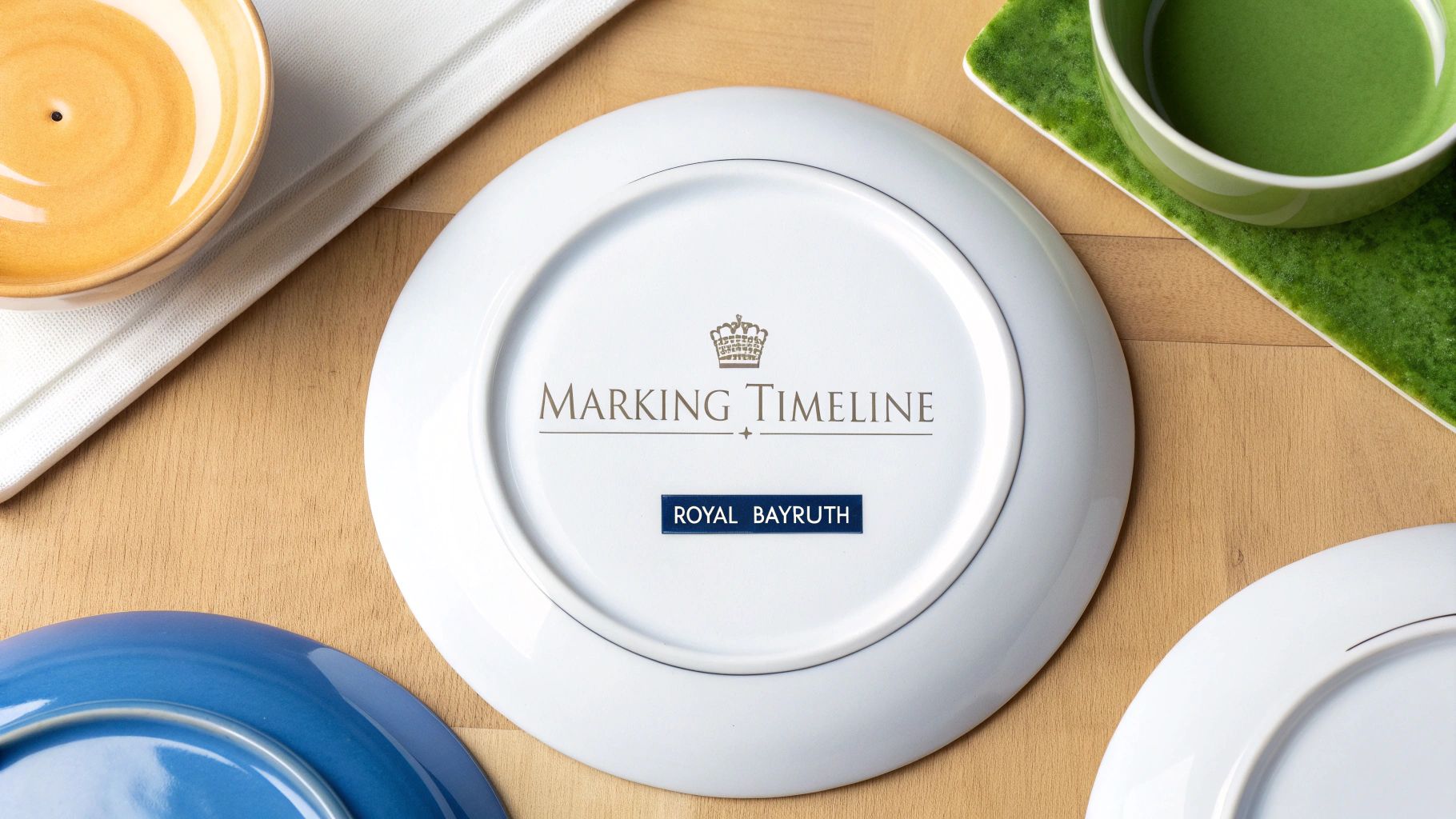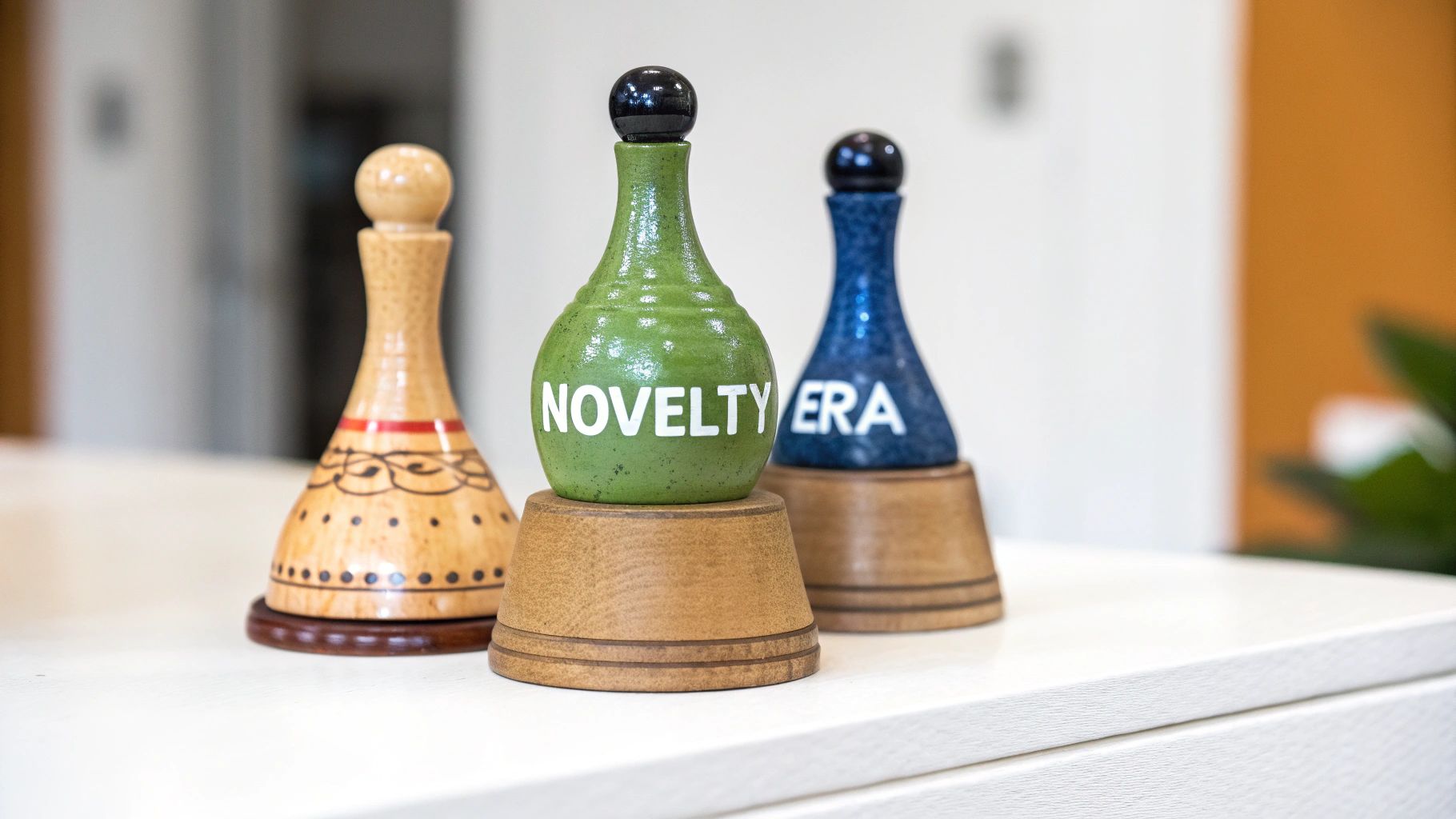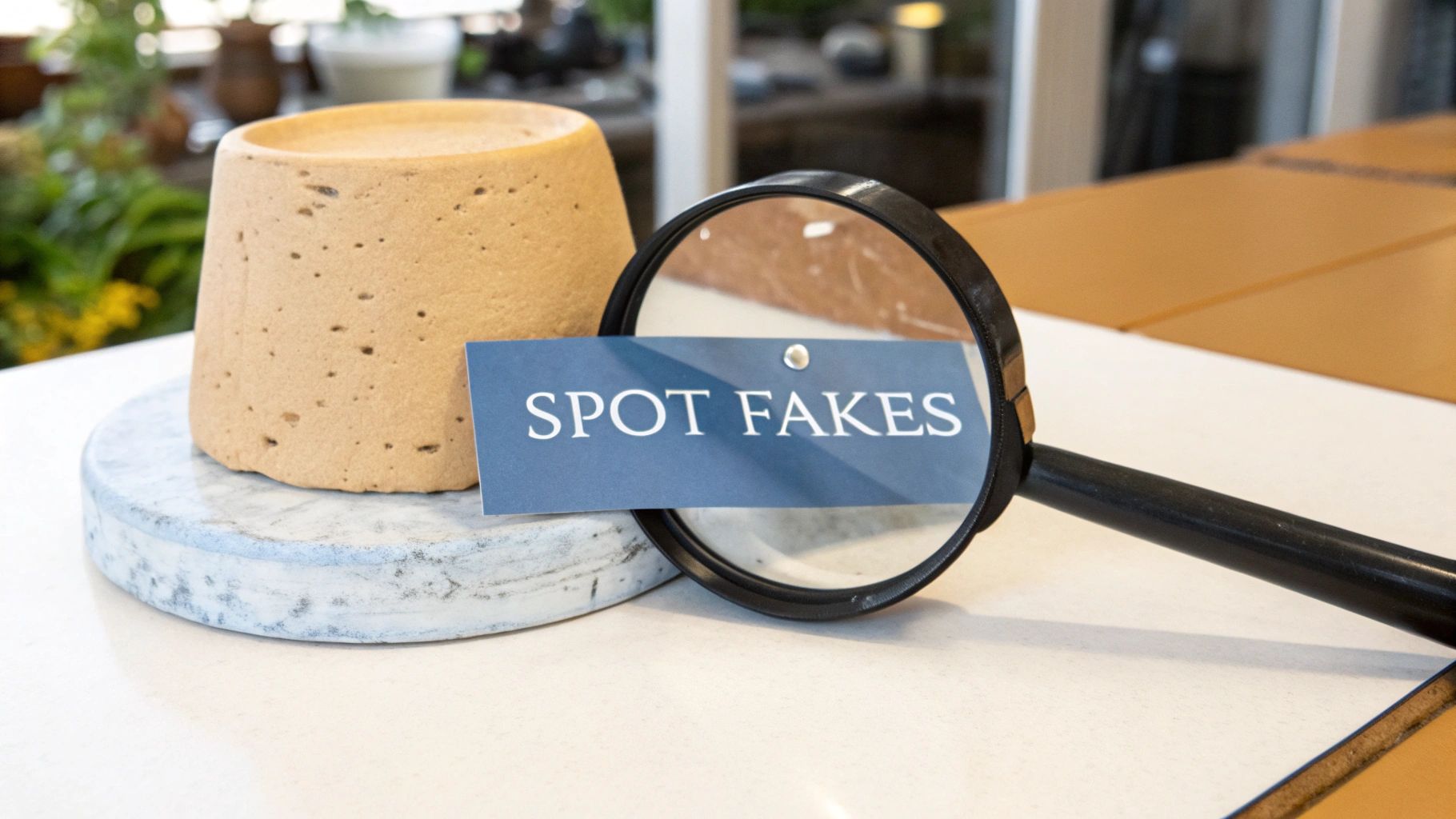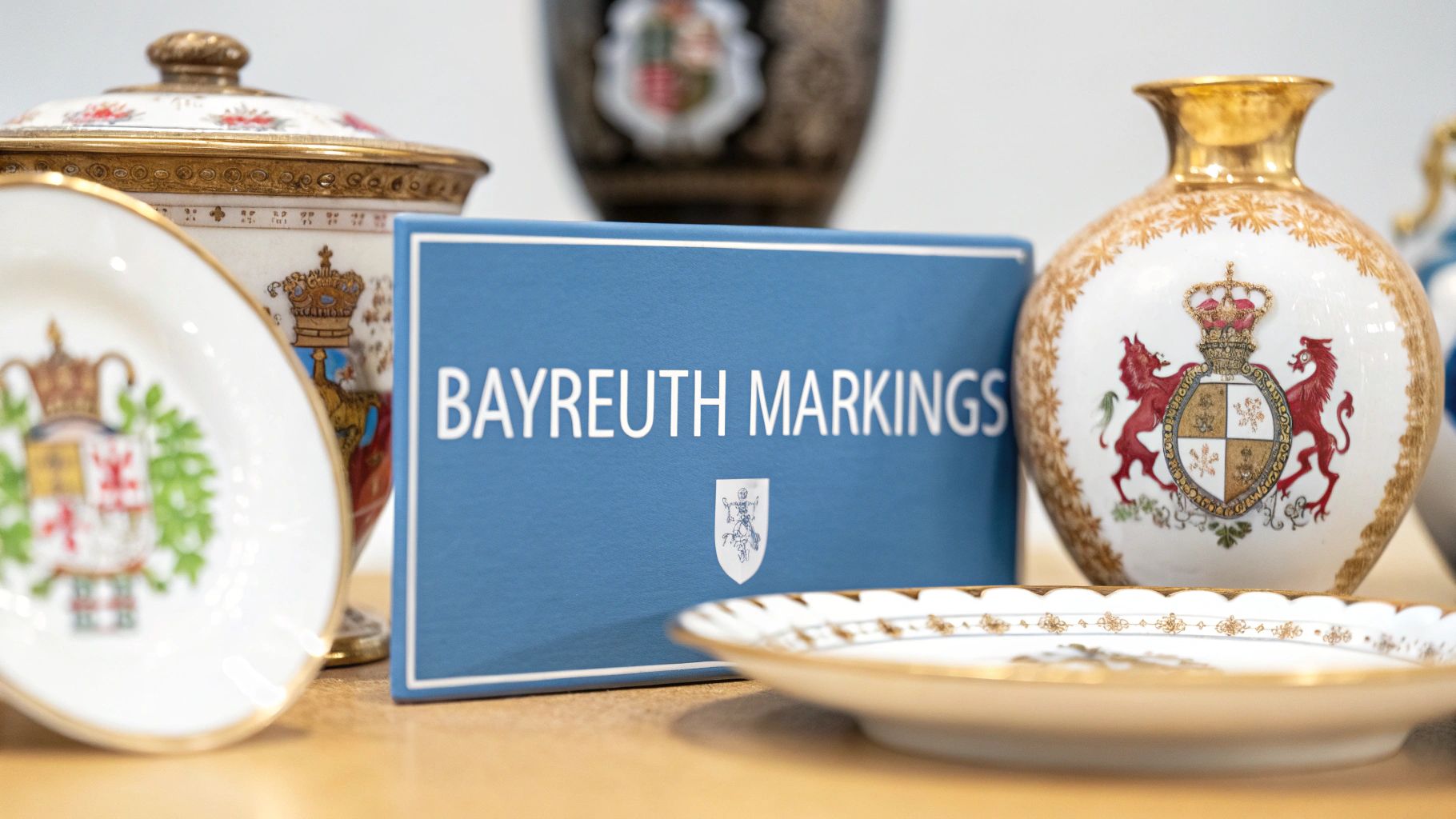Think of the mark on the bottom of a piece of porcelain as its birth certificate. For Royal Bayreuth, these official stamps and crests are a direct line to the piece's history, telling you where and, more importantly, when it was made.
Every mark tells a story. The most famous is the blue P.T. crest, used before 1902, and the green crest that came after. Learning to spot these is the very first step any collector takes to date their pieces and understand their value.
Your Quick Guide to Royal Bayreuth Markings

Each unique design on the bottom of your porcelain is like a passport stamp, telling you about a specific era in the factory's long journey. This section is your roadmap to decoding Royal Bayreuth's markings and understanding how they changed over the centuries. These shifts weren't random; they were often tied to huge historical events, new factory owners, and the changing tastes of a global market.
Getting a handle on the timeline of these marks is the most fundamental skill for any collector. Before you can even begin to talk about value or rarity, you have to place your piece in the right historical context. That's exactly what we'll do here, starting with the big picture and then zeroing in on the details.
A Framework for Identification
To get started, it helps to see the whole timeline at a glance. Royal Bayreuth's history can be neatly broken down into distinct periods, each with its own signature marking style. This framework helps you quickly narrow down the age of a piece you're holding.
Here are the key marking periods to know:
- The Early Unmarked Era (Late 1700s): The factory's very first pieces often had no mark at all. If you're lucky, you might find a simple impressed "T" for Tettau.
- The Blue Mark Era (c. 1850s-1902): This is the period defined by that iconic blue crest. It features a shield with a "P.T." monogram, which stands for Porzellanfabrik Tettau.
- The Green Mark Era (Post-1902): The switch to mostly green marks signaled a new chapter. This change is often associated with the boom in whimsical figural and novelty items made for export.
- Post-War and Modern Era (1940s-Present): After World War II, marks often got additions like "U.S. Zone", reflecting the political reality of the time.
Thinking about it chronologically makes a complex topic much simpler. If you want a broader look at how different porcelain makers used their stamps, our guide to identifying vintage pottery marks is a great resource.
Key Takeaway: The color and design of a Royal Bayreuth mark are your biggest clues for dating a piece. That simple color shift from blue to green represents a major dividing line in the factory's history.
Royal Bayreuth Markings Quick Reference Guide
To make identifying your pieces even easier, I've put together a quick reference table. Just match the characteristics of the mark on your piece to the corresponding era below. It's a fantastic starting point for any investigation.
| Era / Period | Key Mark Characteristics | Approximate Date Range |
|---|---|---|
| Early Production | Unmarked or an impressed "T" | 1794 - Mid-1800s |
| Classic Blue Mark | Blue crest with "P.T." monogram | Mid-1800s - 1902 |
| Transitional Green Mark | Green crest, often with "Royal Bayreuth" | 1902 - WWI |
| Post-War Period | Green or black marks, may include "U.S. Zone" | 1945 - 1949 |
| Modern Era | Simplified marks, often with company name | 1950s - Present |
With this table, you can quickly get a feel for where your piece fits into the grand history of Royal Bayreuth porcelain.
The Story Behind the Marks
Every mark on a piece of Royal Bayreuth porcelain tells a story of survival, artistry, and prestige. To really get what these marks mean, you have to go back to when the factory first started in 1794 in Tettau, a small town deep in Bavaria, Germany. This isn’t just about stamps on pottery; it’s a living history of a company that weathered royal sanctions, devastating fires, and world wars.
The earliest pieces from the late 18th century are like ghosts in the collecting world. They were usually completely unmarked, which makes them incredibly tough to identify. Every once in a while, a piece from this early period pops up with a simple, hand-impressed 'T' for Tettau. Finding one is a real treat for any collector—it's a direct link to the factory’s humble beginnings before it became a household name.
From Humble Beginnings to Royal Recognition
For decades, the factory quietly built its reputation on quality craftsmanship, and that dedication didn't go unnoticed. Eventually, the Bavarian royal family granted the factory a royal sanction, a huge honor that allowed it to add "Royal" to its name. This was more than just a fancy title; it was a powerful seal of approval that boosted the brand's reputation across Europe and beyond.
This royal connection became a core part of its identity, a promise of exceptional quality that the factory would later bake right into its markings. The journey from an unmarked local pottery to a royally sanctioned porcelain house is the first chapter in the Royal Bayreuth story.
A Mark of Resilience: The history of Royal Bayreuth markings is a mirror reflecting the factory's incredible ability to adapt. Every change in the mark, whether a new color or an added word, was a response to a major historical event or a savvy business decision.
A Turning Point Forged in Fire
The single biggest event to shape the Royal Bayreuth marks was a catastrophic fire that ripped through the factory in 1897. It was a disaster, but it also became a catalyst for reinvention. As the factory rose from the ashes, it launched a major rebranding effort, adding the words ‘Royal Bayreuth’ to its crest for the very first time. This was a calculated move to solidify its identity and lean into its royal privilege in an increasingly crowded global market.
This evolution was right in line with what other European porcelain makers were doing at the time—updating their marks to appeal to international buyers. Adding 'Bayreuth' might have also been a nod to the scientific work of Alexander von Humboldt, a Bayreuth local who played a key role in developing fine white porcelain. This era produced marks that included crests, the full ‘Royal Bayreuth’ name, and ‘Bavaria,’ a combination that stuck around until about 1919. To dig deeper into this transformative period, you can explore the detailed history on royalbayreuth.org.
How Historical Events Shaped the Marks
The story doesn't stop there. The markings continued to act as a historical diary, recording the seismic shifts of the 20th century. Each new variation gives us another clue, allowing collectors to pinpoint a piece's place in time with surprising accuracy.
Here’s a quick look at how major events left their imprint:
- World War I: The war threw a wrench in trade and production, which led to subtle changes and simplifications in the marks used during and right after this period.
- The Post-WWII Occupation: After World War II, Germany was divided into occupation zones. Pieces made for export between 1945 and 1949 often have the words "U.S. Zone" added to the mark. This small detail is a powerful historical flag.
- Ownership Changes: Over the course of the 20th century, the factory changed hands a few times. These shifts are often reflected in new, simplified, or modernized versions of the classic crest, signaling the start of a new corporate chapter.
Once you understand this rich history, you're no longer just looking at a stamp on the bottom of a plate. You're reading a timeline etched in porcelain, connecting your piece to the larger story of one of Germany's most enduring and celebrated porcelain makers. That context is what turns a simple collectible into a tangible piece of history.
Decoding the Iconic Blue Mark Era
For most collectors, the classic blue mark is the very symbol of early Royal Bayreuth porcelain. Seeing that mark is like finding a time capsule; it instantly places a piece in a highly desirable period, specifically before 1902. Getting to know the little details of this mark is probably the most important skill for anyone who's serious about collecting the factory's antiques.
The choice of blue wasn't random. In the world of European porcelain, cobalt blue was the color of prestige and quality. It was one of the only colors that could survive the blistering heat of the kiln, which meant the mark could be applied under the glaze. This made it a permanent signature, safe from wear and impossible to fake or remove.
The Anatomy of the Blue Crest
The classic blue mark is much more than a simple stamp—it’s a detailed crest packed with meaning. Right in the middle, you'll find a shield with the monogram "P.T.", which stands for Porzellanfabrik Tettau (Tettau Porcelain Factory). This is the core identifier, tying the piece directly back to its home.
On either side of the shield, you’ll see two figures: a knight on the left and a lion on the right, both standing on their hind legs. A crown sits on top, a nod to the royal privilege granted to the factory. Underneath it all, the founding year, 1794, is often stamped, grounding the piece in the company's long and rich history. Learning to spot each of these elements is the first step to authenticating a genuine blue mark.
Here’s a fantastic example of the blue P.T. crest, showing all the key parts we just talked about.

You can clearly see the shield, the "P.T." monogram, and the supporting knight and lion—all tell-tale signs of this specific era.
Distinguishing Authentic Marks from Reproductions
Just like with any valuable antique, fakes and reproductions are out there. The secret to spotting a real early blue mark is in the small details that forgers almost always mess up. An original mark from this period has a certain handmade quality to it, while a modern copy can often look a little too perfect or sterile.
To really train your eye, zero in on these three critical areas:
- Clarity and Detail: Authentic marks should have clear lines, even if they aren't stamped perfectly. You should be able to make out the knight and the lion, not just a blurry blob. The "P.T." letters should also be crisp.
- Color Richness: The cobalt blue used in the 19th century has a deep, rich hue that modern inks struggle to replicate. Reproductions often use a brighter, flatter blue. The color on a genuine piece should feel like it's in the porcelain, not just sitting on the surface.
- Font and Style: Take a close look at the numbers in "1794." On authentic pieces, the font is distinctly from that period. If the numbers look too modern or generic, that's a huge red flag that the piece isn't as old as it claims to be.
Expert Tip: If you can, place a piece you're unsure about next to one you know is authentic. Comparing them side-by-side makes subtle differences in color, clarity, and detail pop right out. It's one of the fastest ways to learn what to look for.
Learning the ins and outs of the blue mark era is a must for any collector. These marks aren't just labels; they are intricate symbols of a key time in the factory's past. Understanding their story and details gives you the power to date and authenticate pieces with confidence, ensuring your collection is built on real history. This kind of attention to detail is just as important when identifying other European porcelain, like the various Carlsbad Austria china marks. When you focus on these elements, you can navigate the world of early Royal Bayreuth with a well-trained eye.
Understanding the Shift to Green Marks

As the calendar pages flipped into the 20th century, a big change was happening on the bottom of Royal Bayreuth porcelain. The classic blue mark that had defined the brand for decades started to disappear, making way for a vibrant green crest. This wasn't just a random style choice—it was a smart business move that signaled a whole new era for the factory.
This transition to green Royal Bayreuth markings, which kicked off around 1902, is a huge clue for collectors. It helps you zero in on a piece’s age and places it right in the middle of one of the company's most imaginative and playful periods. If you're into the factory's more whimsical and decorative wares, getting a handle on this change is absolutely essential.
A New Color for a New Market
So, what was behind the switch from traditional blue to a bold green? It all came down to the company's ambition to win over a massive international audience, especially in the United States and England. At the turn of the century, Royal Bayreuth went all-in on producing an incredible variety of novelty and figural pieces made specifically for export.
We're not talking about your everyday teacups and dinner plates here. The factory unleashed a creative flood of items shaped like animals, fruits, vegetables, and even playing cards. The green mark became the new signature for these wildly popular export items. It was a fresh, modern brand identifier that really popped in a crowded global market.
The Green Mark Takeaway: The easiest way to think about it is this: the green mark was Royal Bayreuth's "Made for Export" stamp. Its appearance goes hand-in-hand with the factory's push to create unique, eye-catching pieces that would appeal to American and English collectors.
Connecting Green Marks to Famous Product Lines
That green crest is forever tied to some of the most sought-after and collectible Royal Bayreuth pieces ever made. When you spot a green mark, there's a good chance you're holding something from one of their famous novelty lines. This link between the mark and the product is a fantastic tool for identification.
Some of the most iconic series produced during this green mark period include:
- The Sunbonnet Babies: These adorable pieces, decorated with illustrations of Kate Greenaway-style children whose faces are hidden by huge bonnets, were an absolute sensation. You'll almost always find them with a green mark.
- Figural Creamers and Pitchers: This category is a whole menagerie of animal-shaped creamers—everything from cats and dogs to eagles and elk. That green stamp is the tell-tale sign of authenticity for these charming collectibles.
- Tapestry & Rose Tapestry Pieces: Famous for their unique, textured finish that looks and feels like woven fabric, these decorative items were a signature of early 20th-century production and carried the new green mark.
The markings evolved right alongside market demands. Between the late 1890s and World War I, the factory churned out an incredible number of figural and novelty items that collectors go crazy for today. Interestingly, because these pieces were made for export, they are actually quite rare to find in Germany. The company's strategic use of different marks, like the bright-green crest, was key to branding and authenticating these items for buyers overseas. For a deeper dive, you can get more details on how these export strategies shaped collecting from South Coast Today.
The Famous Devil and Cards Connection
If there's one series that's practically synonymous with the green Royal Bayreuth marking, it's the "Devil and Cards" line. These striking pieces, featuring a mischievous red devil playing with a deck of cards, are the holy grail for many collectors. The series includes creamers, pitchers, ashtrays, and match holders, all decorated with this iconic and slightly wicked motif.
The green crest is the definitive mark for this line, period. Its presence not only helps date the piece to the early-to-mid 20th century but also confirms it's a genuine article from this highly coveted series. For collectors specializing in these specific novelties, seeing that flash of green is the first sign of a major score. It just goes to show how a simple color change was part of a brilliant strategy to brand and protect their most creative products on the world stage.
Navigating Post-War and Modern Marks
The middle of the 20th century threw Royal Bayreuth into another period of massive change. The markings from this era are like a diary, recording the economic and political turmoil of the time. For collectors, these later marks tell a fascinating story of resilience, adaptation, and the struggle to stay relevant in a modernizing world.
This chapter in the factory's history is less documented than the famous blue and green eras, but it’s just as important for correctly identifying pieces from the company’s later years. It all starts right after World War II, a time of immense upheaval in Germany, and the factory's markings immediately began to reflect the new political reality.
The "U.S. Zone" Signature
One of the most precise dating tools you'll ever find on Royal Bayreuth porcelain is a small but powerful phrase: "U.S. Zone." This addition is a direct result of the Allied occupation of Germany after the war. Any piece you find bearing this mark can be confidently dated to the period between 1945 and 1949.
This marking wasn't just a whim; it was a requirement for all goods produced in the American-occupied zone that were destined for export. For collectors, it's a definitive historical timestamp.
- What it looks like: The phrase "U.S. Zone" or sometimes "Made in U.S. Zone" was usually added right alongside the standard green or black Royal Bayreuth crest.
- Why it's important: It provides an incredibly narrow and accurate date range, making these pieces valuable historical artifacts, not just collectibles.
Seeing "U.S. Zone" on a piece of Royal Bayreuth is like finding a specific date written on the bottom. It anchors the item to a unique four-year period, taking a lot of the usual guesswork out of dating antiques.
A New Era Under New Ownership
The post-war landscape was tough for many German industries, porcelain included. Stiff competition and changing consumer tastes created immense pressure. In 1957, this led to a major turning point when Royal Bayreuth was acquired by the Seltmann Weiden group, another well-known German porcelain maker.
This change in ownership kicked off a new era of production and, you guessed it, new marking styles. The focus shifted to efficiency and standardization to stay competitive, a business reality that was reflected in the simplified marks that began to appear. The intricate crests of the past were often replaced with more straightforward, modern logos that were quicker and cheaper to apply.
The factory had grown significantly over the decades. By the end of the 19th century, about 200 people worked there, a number that swelled to 600 employees in the 20th century. The 1957 takeover by Seltmann Weiden was a strategic move to combine production facilities and fight the rising tide of competitive imports from the Far East. Despite these challenges, Royal Bayreuth continued its legacy as a top-tier porcelain producer until it finally closed in 2019. You can learn more about the factory's historical shifts on TheOldStuff.com.
Key Takeaway: The modern Royal Bayreuth markings tell a story of industrial evolution. Simplified designs and new company names reflect the economic pressures and corporate changes that defined the factory's final decades.
As you explore the world of Royal Bayreuth markings, remember that each variation is a clue. From the post-war "U.S. Zone" stamp to the streamlined logos of the late 20th century, these marks give you a clear window into how the factory responded to a changing world, allowing you to piece together the full, rich history of your collection.
How to Spot Fakes and Authenticate Your Pieces

Building a genuine Royal Bayreuth collection takes more than just passion—it requires a sharp, detective-like eye. The antiques market is, unfortunately, rife with reproductions and outright forgeries. But don't let that discourage you. Learning to spot the red flags is the best way to protect your investment and ensure every piece you bring home is the real deal.
Think of it this way: the mark is your first and most important clue. But a good detective looks at all the evidence. You have to consider the porcelain itself, the feel of the glaze, and the overall style of the piece. One of the most common giveaways of a fake is a mismatched mark on an item that just doesn't fit the era.
Your Step-by-Step Authentication Checklist
When you find a potential Royal Bayreuth piece, resist the urge to just glance at the bottom. A more methodical approach will help you catch the subtle inconsistencies that most people miss. Here's a simple checklist to walk you through a proper examination.
1. Scrutinize the Mark's Clarity and Quality
- Is it blurry or crisp? Genuine Royal Bayreuth markings, whether blue or green, should have clean, defined lines. Forgeries often look smudged or fuzzy, as if the stamp was applied in a hurry.
- Can you make out the details? In the crest marks, you should be able to distinguish the little knight and lion. If they look more like indistinct blobs, your suspicion should be high.
- Does the color fit the era? Remember, the rich cobalt blue was the mark used before 1902, with the green mark taking over after that. A bright, modern-looking blue on a piece that's supposedly from the 1880s is a dead giveaway.
2. Examine the Glaze Around the Mark
- Is the mark under or over the glaze? Authentic antique marks, especially the classic blue ones, were applied before the final firing and glazing. The mark should look like it's sealed beneath a perfectly smooth layer of glass.
- Are there signs of tampering? Look closely for tiny scratches, an uneven finish, or a slightly raised feeling around the mark. These can be signs that a fake mark was added to an older, unmarked piece to increase its value.
3. Check for Consistency in Style
- Does the design match the mark's time period? An Art Deco-style vase simply shouldn't have a pre-1902 blue mark. Take a moment to research the popular styles from the period indicated by the mark and see if your piece actually fits in.
Authentication Pro Tip: Always trust your sense of touch. A genuine, underglaze mark will feel completely smooth as you run your finger over it. If you can feel the texture of the mark, it was almost certainly applied over the glaze and is likely a modern reproduction.
Common Misconceptions and Pitfalls to Avoid
Navigating the world of Bavarian porcelain can be tricky, as countless factories operated in the same region. It's easy to get confused, but knowing what to look for will save you from making a costly mistake.
One of the most common errors is assuming any piece marked "Bavaria" is Royal Bayreuth. The word "Bavaria" only tells you the region where it was made, not the specific company. For a piece to be authentic, you need to see one of the official Royal Bayreuth markings, like the iconic crest.
Finally, remember that perfection can be suspicious. A tiny imperfection or a slightly off-center stamp can actually be a good sign in older, hand-stamped pieces. Modern reproductions, on the other hand, are often flawlessly uniform. For more great advice, our guide on how to spot fake antiques has excellent tips that apply across all collecting fields. By combining knowledge with careful observation, you can build your collection with true confidence.
A Few Common Questions About Royal Bayreuth Marks
Diving into the world of antique porcelain always sparks a few questions. When you're trying to make sense of Royal Bayreuth markings, some of the same mysteries tend to pop up for collectors, both new and seasoned. Getting a handle on these common queries is a great way to build your confidence.
Let's clear up some of the most frequently asked questions and get you on the fast track to identifying these pieces like a pro.
What Is the Oldest Royal Bayreuth Mark?
This is a tricky one. The very first pieces made when the factory opened its doors back in 1794 were often left completely unmarked. This makes them incredibly difficult to identify and, as you can imagine, exceptionally rare. Occasionally, you might find a very early piece with a simple impressed 'T' for Tettau.
But for most collectors, the mark to look for is the blue 'P.T.' crest. This was the first widely used, consistent mark, appearing around the mid-19th century and staying in use until about 1902.
Does a 'Bavaria' Mark Automatically Mean It's Royal Bayreuth?
Not at all, and this is a classic stumbling block for new collectors. Seeing the word "Bavaria" simply tells you the piece was made in that specific German state.
Think of 'Bavaria' as a regional stamp, almost like "Made in California." Many different porcelain factories operated there and used that mark. To know for sure if you have a genuine Royal Bayreuth, you need to find the company’s own unique crest or name right there with it.
Why Are Some Marks Different Colors?
The color of the backstamp is one of your best friends when it comes to dating a piece. Royal Bayreuth intentionally changed the colors over time to signify different production periods.
- Blue Marks: This is the classic color for the early stuff. If you see a blue mark, you're likely looking at a piece made before 1902.
- Green Marks: The factory made the switch to green marks right after 1902. This change happened right as they started ramping up production of their famous figural and novelty items for the export market.
Feeling like you're drowning in porcelain? Curio can be your lifeline. Just snap a picture of any item, and our app instantly gives you its identity, a bit of history, and an estimated value. It turns that feeling of confusion into the thrill of discovery. Download Curio and start learning the stories behind your treasures today at https://www.curio.app.
